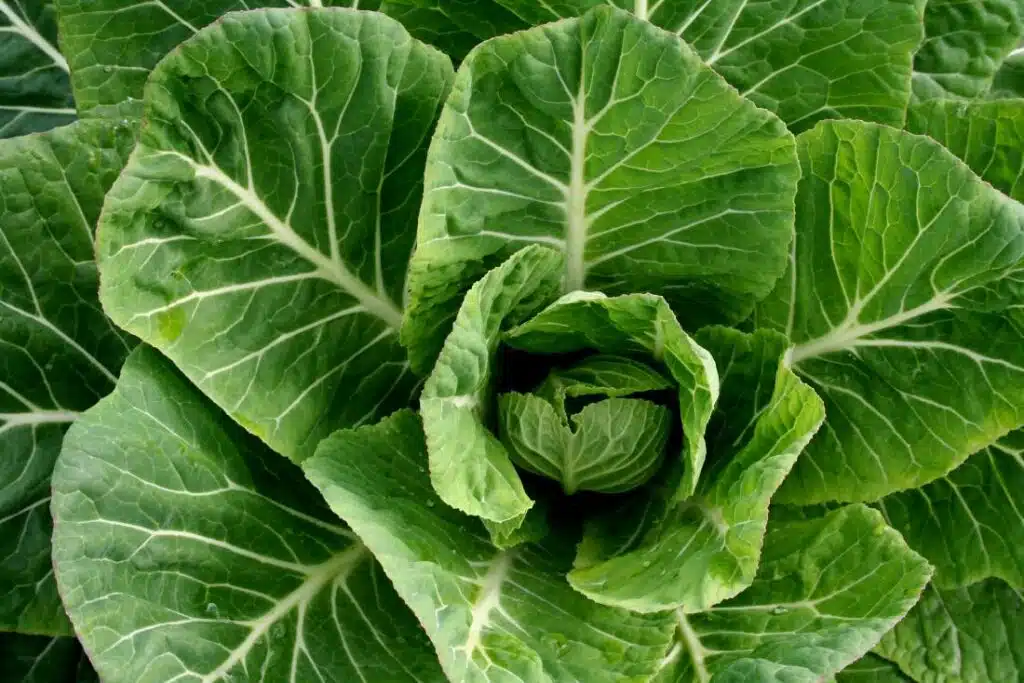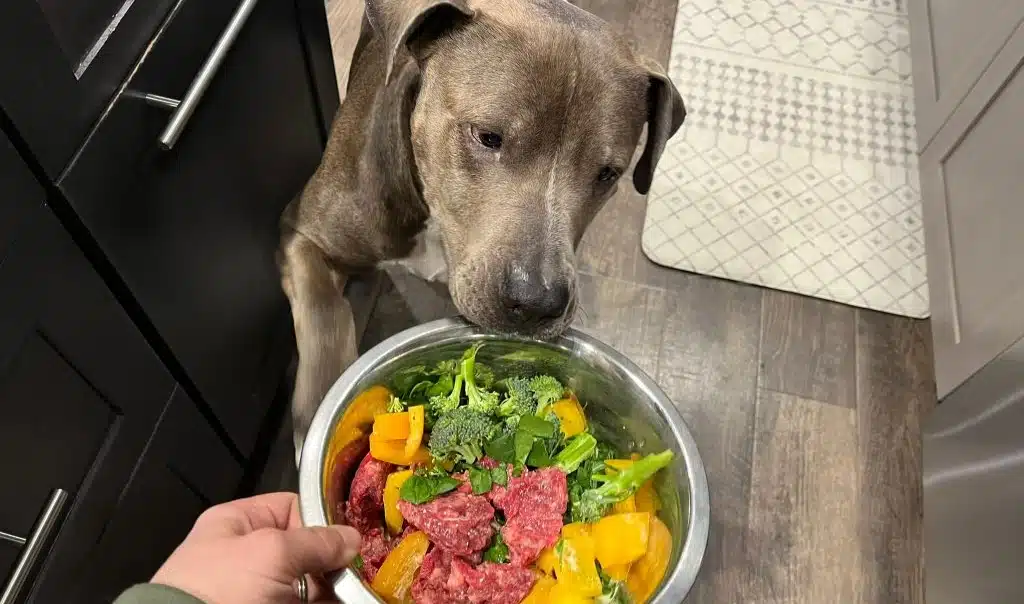Can Dogs Eat Collard Greens? Collard greens—a vibrant, leafy vegetable often found in Southern cuisine—have made their way into our kitchens and hearts. But what about our canine companions? If humans can enjoy collard greens, can dogs safely partake in this nutritious green delight?
Table of Contents
As a responsible pet owner, understanding the benefits, risks, and proper preparation of collard greens is essential. In this comprehensive guide, we’ll explore everything from the basics to advanced tips, ensuring that it becomes the ultimate resource for readers seeking information on this subject.
What are Collard Greens?
Collard greens are like the cousins of cabbage and broccoli. They have big, dark-green leaves that people in the South of the U.S. have loved to eat for a very long time. They taste a little bit bitter but are usually cooked with other greens that are softer and not so bitter.

People in the South have a special meal on New Year’s Day where they eat collard greens with salty meat to hope for a lucky year. These greens are also very special in African-American culture and history.
So, collard greens are not just yummy; they tell a story about the people and places where they are grown and eaten.
2. The Nutritional Value of Collard Greens for Dogs
Collard greens are packed with nutrients that can benefit your dog’s health. Here’s why they’re a great addition to their diet:
1. Vitamins
Collard greens are rich in essential vitamins that contribute to your dog’s overall health:
- Vitamin A: It’s like night-vision goggles for dogs, helping them see better and keeping germs away.
- Vitamin C: Like a shield, it protects their skin and makes sure they don’t get sick.
2. Minerals
These leafy greens also provide important minerals for your dog:
- Calcium: Super strong bones and teeth, so they can chew toys (and not your shoes).
- Manganese: Helps heal boo-boos faster and keeps bones growing just right.
3. Fiber
Collard greens contain fiber, which can aid in digestion and be helpful for dogs with gastrointestinal issues or weight management concerns.
Remember, it’s important to ensure that collard greens are prepared and served in a way that is safe for canine consumption. In the next section, we’ll explore the best practices for preparing and serving collard greens to your dog.
By adding collard greens to your dog’s meals, you’ll be giving them a range of essential nutrients that support their overall well-being.
Also Read: Smegma Removal and Treatment: How to Clean Dog Smegma by Yourself
Below is a chart outlining the nutritional value of collard greens for dogs:
| Nutrient | Benefit for Dogs | Serving Tips |
|---|---|---|
| Vitamins A, C, K | Support immune system, skin & coat health | Steam leaves, chop, and mix with food |
| Folate | Aids in metabolism and DNA synthesis | Serve without stems for easier digestion |
| Riboflavin | Promotes energy production | Small amounts; less than half a cup |
| Fiber | Helps with regular digestion | Introduce slowly to avoid digestive upset |
| Calcium | Essential for bone health | Avoid for dogs with kidney or bladder stones |
| Manganese | Supports bone health and enzyme functions | Cook to improve digestibility |
Detailed Composition of collard greens
| Nutrient | Amount per 1 cup (chopped) | Percent Daily Value (based on a 30-pound dog’s needs) |
|---|---|---|
| Calories | 11 | – |
| Protein | 1g | 17% |
| Fat | 0.1g | – |
| Carbohydrates | 2g | – |
| Fiber | 2g | 20% |
| Calcium | 84mg | 8.4% |
| Iron | 0.5mg | 3.6% |
| Vitamin A | 10548 IU | 263% |
| Vitamin C | 34.6mg | 58% |
| Vitamin K | 229.8mcg | 288% |
| Folate | 59.4mcg | 30% |
| Potassium | 220mg | 6% |
Potential Risks and Considerations
When it comes to dogs eating collard greens, there are some potential issues to consider:
- Digestive Upset: Unfortunately, in addition to the chock-full nutritional values of collard greens, they are also extremely high in fiber. Sudden intake of high-fiber foods may only result in digestive issues like gas and diarrhea in dog’s intestinal tracts.
- Thyroid Interference: Such plants have goitrogens that do interfere with the thyroid system when in massive consumption. While the fine during the processing of the collard greens may neutralize some goitrin compounds.
- Calcium Oxalate Concerns: Besides that, collard greens also contain a large amount of calcium oxalates, some of which could cause the development of urinary stones in people if they are predisposed to that condition. If your dog has a urinary problematic history, you must regulate the serving of high-oxalate foods as collard greens.
When it comes to assessing if to give your dog a collard green, you must acknowledge that there are certain benefits and negative consequences. While it is significant to keep track of your dog’s reactions on the introduced ingredient, it might be a good idea to pay a visit to a vet at this stage – the doctor will provide you with the best guidance on how to cover all to-do’s in connection with your dog’s health.
4. Serving Collard Greens to Your Dog: Preparation and Portions
When it comes to serving collard greens to your dog, proper preparation is key to ensuring safe consumption. Here are some recommended methods for preparing collard greens for dogs:
- Washing: Thoroughly wash the collard greens to remove any dirt, pesticides, or chemicals that may be present on the leaves. This step helps prevent any potential digestive issues for your dog.
- Cooking: It’s advisable to lightly cook or steam the collard greens before serving them to your dog. This can help break down the tough cellulose in the leaves, making the nutrients more accessible for digestion.
Incorporating collard greens into your dog’s diet should be done in moderation and as part of a balanced meal plan. Here are some best practices for feeding collard greens to dogs:
- Balanced Diet: Collard greens should complement your dog’s regular diet, which consists of high-quality commercial dog food or a vet-approved homemade diet. They should not replace essential components of their diet.
- Serving Sizes: The recommended serving size of collard greens for dogs varies based on their size and weight. As a general guideline, small dogs can have around one teaspoon, while larger dogs can have up to one tablespoon of cooked collard greens per meal.
Here is a quick snapshot for better understanding
| Preparation Steps | Description |
|---|---|
| Selection | Choose fresh, organic collard greens. |
| Cleaning | Wash thoroughly to remove dirt and pesticides. |
| Preparation | Remove tough stems and chop leaves into small pieces. |
| Cooking | Steam for about 10 minutes or boil for 5 minutes. Avoid raw greens as they can be a choking hazard. |
| Serving | Introduce gradually. Mix small portions with regular food. |
Always consult with your veterinarian regarding the appropriate portion sizes and frequency of feeding collard greens to your dog based on their individual dietary needs and health conditions.
5. Monitoring Your Dog’s Response to Collard Greens

When introducing collard greens into your dog’s diet, monitoring their response and ensuring their safety is essential. Here are some key points to consider:
Signs of Digestive Issues or Allergies
While collard greens are generally safe for dogs, some canines may have sensitivities or allergies to certain foods. Keep an eye out for any signs of digestive issues such as diarrhea, vomiting, or excessive gas. These could be indications that your dog is having difficulty digesting the collard greens or is experiencing an allergic reaction.
Important Precautions When Introducing Collard Greens
It’s crucial to introduce collard greens gradually into your dog’s diet, especially if they haven’t had them before. Start by offering a small amount and observe how your dog reacts. If there are no adverse effects, you can gradually increase the portion size over time. This gradual introduction allows your dog’s digestive system to adjust and reduces the risk of any gastrointestinal upset.
Consult with Your Veterinarian
If you notice any concerning symptoms or if you have any doubts about whether collard greens are suitable for your dog, consult with your veterinarian. They can provide personalized advice based on your dog’s specific needs and health conditions.
Monitoring your dog’s response to collard greens ensures that you can identify any potential issues early on and make appropriate adjustments to their diet if necessary. By being attentive and proactive, you can ensure the safety and well-being of your furry friend.
Remember, every dog is unique, and what works for one may not work for another. It’s important to consider your dog’s individual dietary requirements and consult with a veterinary professional for tailored guidance.
6. Expert Opinion: Can Dogs Eat Collard Greens?
When it comes to feeding collard greens to your furry friend, it’s always important to consider the advice of veterinary experts. While collard greens can be a nutritious addition to a dog’s diet, there are a few factors to take into consideration.
- Digestive Capacity: Dogs have a different digestive system than humans, and some may struggle to fully break down certain plant fibers found in collard greens. This can lead to gastrointestinal upset including gas, bloating, or diarrhea. It’s essential to monitor your dog’s response closely when introducing collard greens for the first time.
- Portion Control: Moderation is key when it comes to feeding collard greens to your dog. While they contain beneficial vitamins and minerals, excessive consumption can lead to imbalances in their diet. Consult with your veterinarian about the appropriate portion sizes based on your dog’s size, age, and overall health.
- Preparation Methods: Properly preparing collard greens for your dog is crucial. Steaming or boiling them until they are soft and easily digestible can help minimize any potential digestive issues. Avoid using seasonings or additives that may be harmful to dogs, such as garlic or onions.
- Individual Sensitivities: Just like humans, dogs can have individual sensitivities or allergies to certain foods, including collard greens. Watch out for any signs of allergic reactions or adverse effects such as itching, rashes, or difficulty breathing. If you notice any concerning symptoms, consult with your veterinarian immediately.
In the end, whether or not you should include collard greens in your dog’s diet depends on the individual dog and their specific dietary needs. Consulting with a veterinarian who has expertise in canine nutrition is crucial for personalized advice tailored to your pet’s unique requirements.
Remember that while collard greens can offer nutritional benefits when fed in moderation and prepared properly, they should never replace a well-balanced and complete diet specifically formulated for dogs.
Conclusion
Final Thoughts on Feeding Collard Greens to Dogs
Collard greens can be a nutritious addition to your dog’s diet if introduced and monitored carefully. Their rich array of vitamins and minerals can offer health benefits, but potential risks and digestive considerations should be taken into account.
Importance of Consulting a Vet
When incorporating collard greens into your dog’s diet, consulting with a veterinarian is crucial for personalized advice and ensuring the overall well-being of your pet.
Remember, every dog is unique, and professional guidance can help tailor dietary choices to your dog’s specific needs.

